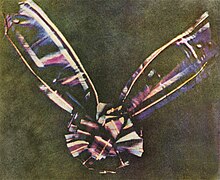James Clerk Maxwell Foundation
By supporting physics and mathematics, it honors one of the greatest physicists, James Clerk Maxwell (1831–1879),[2] and while attempting to increase the public awareness and trust of science.
The Foundation awards grants and prizes and supports mathematical challenges designed to encourage young students to study as mathematicians, scientists and engineers and become leaders in the world.
The James Clerk Maxwell Foundation was formed in 1977 by the late Sydney Ross,[3] Professor of Colloidal chemistry at Rensselaer Polytechnic Institute in New York, USA.
[4] Since 1993, the house has been refurbished to its original standard and a small museum has been developed which features Maxwell’s family, life and scientific advances.
[8] The restored entrance hall contains a copy of the bust of Maxwell by Charles d’Orville Pilkington Jackson, the original is located at Marischal College, Aberdeen.
The final portrait is of Maxwell’s lifelong friend and scientific colleague Peter Guthrie Tait who was the Professor of Natural Philosophy at Edinburgh University.
One of Maxwell’s major technical advances is the first full colour projected image produced at a time when only black-and-white photography was known.
On display is a replica of part of the balance arm of Maxwell’s apparatus to measure the ratio of electromagnetic to electrostatic units of electrical charge.
This room (originally John Clerk Maxwell's business office when he practised as an advocate in Edinburgh) contains wall displays[12] celebrating Maxwell’s other major scientific achievements: his work on governors for machine speed control; Maxwell–Boltzmann distribution and his contribution to statistical physics; discovery of the form of Saturn's rings; contributing to the committee that defined the Ohm; reciprocal figures or frames for the design of structures such roofs and bridges.
The final set of wall panels describes the friezes on his Edinburgh statue placing Maxwell’s contributions in context between Newton and Einstein.
They sample the history of science and mathematics from Copernicus onwards, arriving at Maxwell’s contemporaries Michael Faraday and Lord Kelvin.
It displays material relating to the Clerk family, Maxwell’s childhood, early life and career, including some of his poetry.





